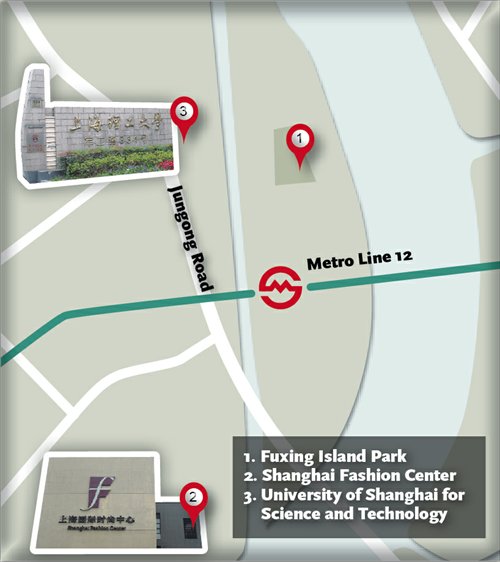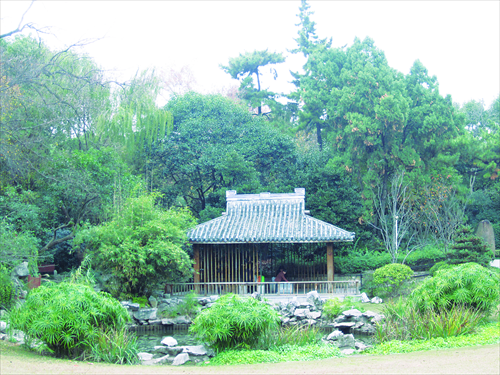Fuxing Island Station
Nature meets industry down by the riverside
Editor's Note
This year is the 21st anniversary of the opening of the Shanghai metro. The subway has facilitated more than 13 billion journeys during its 21 years, and half of Shanghai citizens cite the metro as their favored mode of transport. To commemorate the anniversary, each week the Global Times will take an in-depth look at one metro station and its surroundings. In the case of downtown stations, we will focus on points of interest within walking distance; while for suburban areas, we will cast our net a little wider.
Fuxing Island is a crescent islet of just 1.13 square kilometers lying on a bend of the Huangpu River in eastern Yangpu district, separated from the mainland by a canal-width strip of muddy water. It's a secluded and sparsely populated area with a dense growth of evergreen trees, forming a retreat on the river.
Once a simple mud flat, the island was developed by the city's former dredging authorities in the 1920s and was later used for arsenal storage by Japanese forces during World War II. It was subsequently developed into an industrial complex full of warehouses and shipyards, and still bears the aging marks of heavy industry.
Plans are afoot to redevelop the area into an eco-friendly complex, making its name "Fuxing," which means "renaissance," particularly apt.
Emerging from Exit 2 of Fuxing Island Station on metro Line 12 will bring you onto a long, tree-lined promenade called Gongqing Road. Strolling along the road, you can often hear the rumble of machines in the surrounding cargo wharves. The road is dominated by aging factories and garages with walls covered in ivy. The air often fills with dust courtesy of the heavy trucks trundling past.
Despite the decrepit hulking industrial complexes, the neighborhood offers some unexpected attractions that make it well worth a visit.

Fuxing Island Park is a surprisingly quaint and well-kept Japanese-style park.
Fuxing Island Park
Fuxing Island Park (386 Gongqing Road, 6568-3806) is a surprisingly quaint and well-kept Japanese-style park. It is the former site of the Sports Society of Shanghai Conservancy Board and was occupied by the Japanese army during the War of Resistance against Japanese Aggression (1937-45).
The Monument to Recovery of Fuxing Island was built in the park in 1948 and destroyed in 1967.
After the liberation of Shanghai in 1945, the Sports Society was taken over by Shanghai Public Works Bureau in 1951. A giant stone at the entrance serves as a memorial to the park's history.
To the northern end stands the park's most famous attraction, a small unremarkable white house called Bailu (meaning "white hut").
It served as Chiang Kai-shek's final residence before he left the Chinese mainland for Taiwan in May, 1949.
The park has trees of camphor, pomegranates and cherries.
Other leisure facilities include a couple of badminton courts, a Japanese-style pagoda next to a heart-shaped pond, some stone tables and winding stone paths.
The park is small, taking about 15 minutes to walk around. Entrance is free.

Fuxing Island Park is a surprisingly quaint and well-kept Japanese-style park. Photos: Yang Fan/GT
Shanghai Fashion Center
Renovated from the Shanghai 17th Cotton Mill, an old factory house for cotton and textiles built in 1935, Shanghai Fashion Center (SFC) (2866 Yangshupu Road, 6070-8126) is a fashion and creative industry park opened in 2011 and operated by the local fabric giant Shangtex Holding Group Corporation.
The center is split into sections including an outlets area for discount and boutique stores, a food and entertainment area with restaurants and hotels, and a studio office area for holding fashion shows and conferences.
Well-known brands in the premium outlets area often run special discount promotions. A wood decking footpath allows visitors to take a pleasant riverside stroll. The center is open from 11 am to 9 pm on weekdays and 10 am to 9 pm on weekends.
USST
The University of Shanghai for Science and Technology (USST) is a key multidisciplinary public university with major disciplines including engineering, management, commerce, arts and science. The campus (334 Jungong Road) across from Fuxing Island is the main campus of the university.
Built in the Anglo-gothic style with red brick walls and triangular roofs, many buildings there were part of the old University of Shanghai, also known as Hujiang University, which was founded by American Baptists in 1906.
The USST National Science Park in the campus was named a "Shanghai creative industry concentration zone" by Shanghai Municipal Commission of Economy and Informatization and has served as a platform for production, learning and research.
The Herman C.E. Liu Memorial Library is a memorial to the university's first Chinese president, who was killed by Japanese invaders in 1938 and is commemorated with a bust in front of the building.